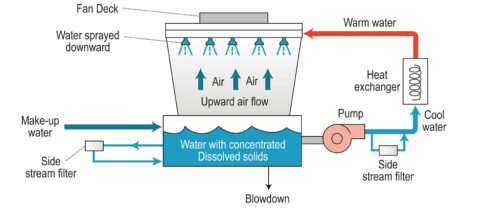 Dear All,
Dear All,Suspended solids (particulates or turbidity) are frequently found in cooling towers. At best these suspended solids will tend to settle out in low velocity areas of the water system (such as the cooling water basin) where they can become a breeding ground for bacteria, requiring frequent cleaning and flushing of the basin. At worst, they can degrade system heat transfer capacity and lead to steep increase in dosing rate and consequently the cost of water treatment chemicals (e.g bactericides).
Modern day cooling tower systems have thus adopted side stream filtration of the water from the cooling tower. Various schemes can be implemented. The basin water inventory may only be filtered and / or side stream filters may be employed at the discharge of the CW recirculation pumps. Refer the simplified flow scheme of side stream filtration for a cooling tower:

When the side stream filter is employed in the discharge of the cooling water recirculation pump discharge, the flow rate required for filtration through side stream filter can be calculated by the following formula:
Side Stream Flow Rate, L/s = ((ppm suspended solids in recirculating cooling water / 200) - 1)*Blowdown Rate, L/s - Metric
Side Stream Flow Rate, gpm = ((ppm suspended solids in recirculating cooling water / 200) - 1)*Blowdown Rate, gpm - USC
From the above formula, it becomes obvious that if the ppm level of suspended solids is ≤200 ppm in the recirculation cooling water, side stream filtration may not be required. However, installation of side stream filter is recommended since suspended solid concentration builds up over time and periodic high build-up would require side stream filtration for the aforementioned reasons.
Pressure sand filters with backwash facilities are commonly employed as side stream filters for cooling towers.
Backwash water for the filters can either be from another source, or if cooling water is used, this water should be considered as part of the cooling tower blowdown. In either case, backwash effluent water must be sent to the waste water treatment plant.
That is all for today's blog entry. Comments are most welcome.
Regards,
Ankur.

 FB
FB








I would like to propose the following idea to calculate the side stream circulation rate.
The main idea is the following water and suspended solid(SS) balance in the whole cooling water(CW) system; no loss in CW, thus no SS loss in circulating loop is assumed:
Overall water mass balance(flow rate): M = E + B + W................(1)
SS mass balance: aM = cB + cS ......(2) <--all SS in M is to be removed by B and S.
Side filter SS balance: cS = dW .......(3) <--all SS in S is to be removed completely by the side filter.
Where,
M=make-up CW, E=evaporation loss, B=blow-down, W=waste sludge purge (from side filter), S=side stream
a=SS conc. in make-up, c=("ALLOWABLE") SS conc. in circulating CW system, d=SS conc. in sludge (to be purged from side filter); the unit of a,c,d is in wppm
Compared with M, E, and B the amount W in eq. (1) could be neglected, and flow rate of side filter can be calculted from eq.(1) and (2):
S = (aM-cB)/c = (a/c)M - B = M/α - B ................(4)
where α = c/a = "RATIO" Allowable Maximum SS to make-up SS ....(5)
If the net SS make-up, aM, is to be totally purged as blow-down, cB, then S becomes 0; so "NO" side filter would be required. If there is "NO" blow-down, then all the sludge shall be purged as d*W (=c*S) by circulating with side-stream rate of S ( =(a/c)*M).
S=0 if a*M=c*B .................................................(4a)
S=(a/c)M if B=0................................................(4b)
The maximum "Allowable" SS concentration quoted by Ankur seems to be 200 wppm.
Please comment on my idea above.
Stefano